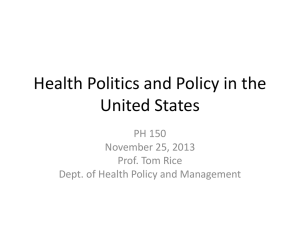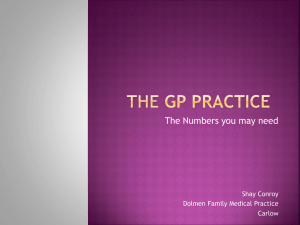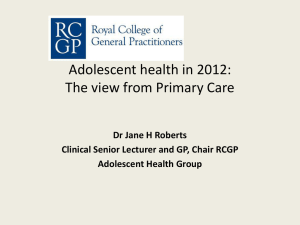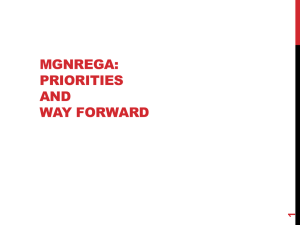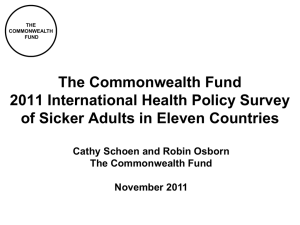Dr Chaand Nagpaul - Developing General Practice
advertisement
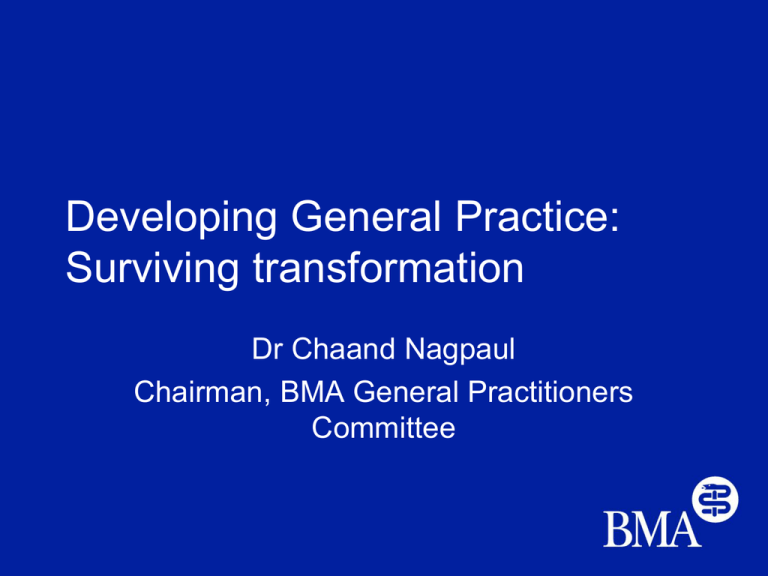
Developing General Practice: Surviving transformation Dr Chaand Nagpaul Chairman, BMA General Practitioners Committee Where we are today - increasing demographic demands on GPs • Rising demand from ageing population • 29% population have a long-term condition • Between 2008-2018 no. of people with 3 or more LTCs predicted to rise from 1.9 to 2.9 million • Patients with LTCs make up 50% of appointments • LONDON- ethnically diverse, non-English speaking, mobile population, additional deprivation indices Where we are today: progressive transfer of care out of hospitals • • • • • • • • Chronic disease management Earlier inpatient discharge Expansion of day care surgery Reduced post op follow up Reduced OP follow up Increased investigations in the community “Out of Hospital Care” – explicit policy direction LONDON effect- hospital closure programme Where we are today understaffed Where we are today understaffed Centre for Workforce Intelligence “Our analysis on the available evidence on the demand for GP services points to a workforce under considerable strain and with insufficient capacity to meet expected patient needs. There is a clear need to substantially lift workforce numbers to more sustainable levels.” Where we are today : underresourced • Between 06/07 – 10/11 – Spending increased on GP services by 10.2% – Spending increased on hospital services by 41.9% • In 2012/13 – £7.8bn spent on general practice – Over £70bn spent on secondary care • No national investment or strategy for GP premises since 2004 Where we are today : under-resourced Year % total investment % excluding dispensed drugs 2004/5 10% N/A 2005/6 10.41% N/A 2006/7 9.83% N/A 2007/8 9.17% N/A 2008/9 8.74% 8.04% 2009/10 8.45% 7.81% 2010/11 8.31% 7.68% 2011/12 8.16% 7.56% 2012/13 8.04% 7.47% Where we are today – overworked and demoralised • DH commissioned 7th worklife survey GPs (Aug 2013) lowest levels of job satisfaction since 2004 contract highest levels of stress since start of the survey series substantial increase in GPs intending retiring next 5 yrs • BMA GPC GP contract imposition survey (Sep 2013) • 9 out of 10 increased workload past year, 100% incr bureaucracy 9 out of 10 say reducing appts and time for patients Nearly 9 out of 10 reduced morale 1 in 2 GPs less engaged with CCG due to workload Today’s political context • • • • • • NO NEW MONEY-austerity - £30b savings by 2020 GP contract changes 2014-15 Workload demands on GP practices continually rising “Equitable funding” - LOSERS & GAINERS Standardisation of care & quality in primary care Increased scrutiny and performance management; NHS England, CQC and CCGs • Prime Ministers Challenge Fund: 7/7 opening • Urgent care- Keogh review • Competition; Monitor Competing in a market • AQP – a reality; APMS, ES, LA commissioning • Competing with commercial providers: advantage of size, business accumen, able to take risk, loss leading contracts • Competing with Foundation trusts (“vertical integration”) • Competing with access and convenience (vs quality)8 a.m-8 p.m/7 days a week • Opportunity costs in competing and tendering • Abolishing practice boundaries; patient choice • Increasing value of global sum £/patient • Challenges of competition greater the smaller the unit Planning for the future • • • • • No practice immune from external pressures and threat Vulnerability increases the smaller the unit Vulnerability for MPIG and PMS losers Implications for all GPs-partners and sessional doctors London effect: Higher prevalence of: single-handed/small practices, inadequate premises BME GPs, salaried and freelance GPs Greater ethnic diversity; London specific demographic needs Securing our future: GP practices working together • Survival of the fittest: economies of scale, ability to compete, sharing opportunity costs, managing financial risk, security in numbers • New opportunities: new/expanded services, new income streams, professional development and new roles, peer support and education, managing workload and risk • Looking after our own, supporting the disadvantaged; supporting small practices; maximising the potential of inadequate GP workforce The weak or disadvantaged • • • • • • • • • Poor, inadequate premises (locked in); CQC vulnerable Small & isolated Challenging population demographics Low GMS funded Poor historic Health Authority/PCT support, development and investment Poor staffing levels Poor management support Not policy savvy Quality and potential of individual GPs obscured Tiers of collaboration • Primary medical services (G/PMS) and enhanced services • New provider models for expanded services in the community; out of hospital care • Avoiding “tears” of collaboration Primary Medical Services (GMS/PMS) • • • • • • GMS/PMS – flexibilities for informal & formal alliances Sharing human resources, cross-cover, training Subcontracting & sharing services across practices Back office functions e.g. PAYE, bulk purchasing Improved access: extended hours DES; Xmas closing Supporting statutory functions/HR/information governance, CQC registration etc • Quality assurance and professional development: clinical governance, peer review, education • Succession planning for potential vacancies Structural options for new provider models • • • • • • • • • • Form to follow function; depends on purpose Simple alliances; sharing premises and staff Formal mergers as partnerships GP co-operatives Private companies limited by shares Community interest companies (CICs), social enterprises Charity or charitable incorporated organisation (CIO) Limited Liability Partnership Companies limited by guarantee NEED EXPERT LEGAL ADVICE Principles of working together • What is purpose? Shared vision, equity of opportunity and ownership, avoid “corralling” practices • Preserving the essence & success of general practice • Benefits to patients • Supporting the weakest and disadvantaged GPs and practices • Creating synergy vs “takeovers” • Providing true contractual and career development opportunities Challenges and risks to collaborative working • Loss of autonomy, loss of “essence” of general practice (patients like small practices) • Differences in opinions and philosophies • Different starting points • Sharing unequal historic resources • Developing trust and collective ethos • Legal & liability implications • Setting up costs • TIME to plan It can happen and work • Derbyshire Health United: Not for profit social enterprise, 300 GPs covering 1m patients, provides 4 walk-in centre services, OOH triage and call handling • Midlands Medical Partnership: 33 GP partners, 4 GMS contracts, 60000 patients • AT Medics: Private company limited by shares, across 8 CCGs in London, corporate structutr providing core and enhanced services, and support for career development • Suffolk GP Federation: not for profit community interest company, 40 practices, 360,000 patinets • Sessional Drs: www.pallantmedical.co.uk – a chambers of freelance locum GPs Making it happen • • • • • • Can’t afford ostrich approach Start talking within your practices and between practices Premises constraints – estate strategy with hubs IT infrastructure to support networks LMC role CCG role supporting practices and resource shifts from secondary care • AT role - supporting collaboration, resources • Learn from others - look at what’s working elsewhere GPC guidance • “Collaborative GP alliances and federations” October 2013 • “Guidance for practices on how to employ shared staff” October 2013 • GPC survey of GPs on collaboration (Feb 2014) http://bma.org.uk/working-for-change/negotiating-forthe-profession/bma-general-practitionerscommittee/priorities/gpc-vision Integrated care, built around the practice “Community health care teams built around GP practices. Collaborative working across localities with practices either singly or collectively employing or directly managing community nurses who, working together with practice nurses, will provide a seamless and more flexible nursing service for patients in the community.” “Greater collaboration between community pharmacists and practices with a practice- aligned pharmacist undertaking medicines management and other elements of chronic disease management”. Integrated care, built around the practice “Secondary care clinicians and GPs working collaboratively to design and provide care pathways for local areas, bringing more diagnostics and specialist care out of hospital and into community settings, including hospital-based specialists visiting nursing and residential homes and working alongside GPs in practices when appropriate.” Turning solutions in to reality FUNDING: “Government should set a target for NHS England to invest in a year on year increase in the proportion of funding in to general practice” Ending PbR and perverse funding systems – money to follow changing patterns for care WORKFORCE: National strategy for recruitment & retention now Support returners back to work Turning solutions in to reality: PREMISES: Fit for the future - 10 year programme of premises development - Create a GP premises development fund - Practices working together to make maximum use of premises - Guaranteeing reimbursement of running costs EMPOWERING PATIENTS AS PARTNERS - Self care, demand management Changing external mind-sets • 4 hour+ A&E waits due to demand exceeding supply, pressures, need more resources, more A&E Drs… • Waits for GP appointments due to fault of GPs not working hard enough, not open long enough, practice creating obstacles… Changing mind-sets • Investing in hospitals is about investing in care and services • Investing in general practice is about paying GPs more • Is there a way of investing in general practice without necessarily being linked to perceptions of GP pay? 30 Health Spending per Capita, 2010 Adjusted for Differences in Cost of Living Dollars $9,000 $8,233 $8,000 $7,000 $6,000 $5,000 $4,000 $3,000 $3,433 $3,670 $3,974 $4,338 $4,445 GER (11.6%) CAN (11.4%) $5,056 $5,270 NETH (12.0%) SWIZ (11.4%) $3,022 $2,000 $1,000 $0 % GDP NZ UK (9.6%) AUS (10.1%) (9.1%)* * 2009. Source: OECD Health Data 2012. FR (11.6%) US (17.6%) Sicker Adults Cost-Related Access Problems in the Past Year 31 Percent AUS CAN FR GER NETH NZ SWIZ UK US Did not fill prescription or skipped doses 16 15 11 14 8 12 9 4 30 Had a medical problem but did not visit doctor 17 7 10 12 7 18 11 7 29 Skipped test, treatment, or follow-up 19 7 9 13 8 15 11 4 31 Yes to at least one of the above 30 20 19 22 15 26 18 11 42 Source: 2011 Commonwealth Fund International Health Policy Survey of Sicker Adults in Eleven Countries. Sicker Adults Access to Doctor or Nurse When Sick or Needed Care Same or next-day appointment Percent 32 Waited six days or more 100 79 75 79 75 75 70 63 59 59 51 50 23 25 2 4 5 8 10 12 0 Source: 2011 Commonwealth Fund International Health Policy Survey of Sicker Adults in Eleven Countries. 16 23 33 Sicker Adults and Primary Care Physicians Access to After-Hours Care Percent Sicker Adults: Difficult getting after-hours care without going to the emergency room Doctors: Have arrangements for patients to get after-hours care 95 100 94 90 89 81 78 76 75 63 55 50 40 55 56 40 34 25 21 26 0 Source: 2011 and 2012 Commonwealth Fund International Health Policy Surveys. 45 34 34 Sicker Adults with a Chronic Condition Patient Engagement in Care Management Percent reported professional in past year has: AUS CAN FR GER NETH NZ SWIZ UK US Discussed your main goals/ priorities 63 67 42 59 67 62 81 78 76 61 63 53 49 52 58 74 80 71 66 66 56 64 64 63 84 80 75 48 49 30 41 42 45 67 69 58 Helped make treatment plan you could carry out in daily life Given clear instructions on symptoms and when to seek care Yes to all three Base: Has chronic condition. Source: 2011 Commonwealth Fund International Health Policy Survey of Sicker Adults in Eleven Countries. 35 Primary Care Physicians Practice Routinely Receives and Reviews Data on Patient Care Percent routinely receives and reviews data on: AUS CAN FR GER NETH NZ SWZ UK US Clinical outcomes 42 23 14 54 81 64 12 84 47 Patient satisfaction 56 15 1 35 39 51 15 84 60 Hospital admissions and ED use 39 30 9 24 21 43 32 82 55 Source: 2012 Commonwealth Fund International Health Policy Survey of Primary Care Physicians. 36 Primary Care Physicians Doctors’ Clinical Performance is Reviewed Against Targets at Least Annually Percent 100 96 83 80 67 60 53 47 43 43 41 40 37 20 0 UK NZ US AUS NETH FR GER Source: 2012 Commonwealth Fund International Health Policy Survey of Primary Care Physicians. CAN SWIZ Primary Care Physicians Doctor Routinely Receives Data Comparing Practice’s Clinical Performance to Other Practices Percent 100 80 78 60 55 45 40 35 34 32 25 25 20 15 0 UK NZ FR SWZ US NETH AUS Source: 2012 Commonwealth Fund International Health Policy Survey of Primary Care Physicians. GER CAN 37 General practice as a solution • Pride and confidence - UK GPs and general practice provide world leading primary care • Bedrock of NHS: 340m consultations/yr vs 21m in A&E • The most cost-effective part of the NHS? - £130 patient/yr unlimited care vs £200 single OPD PbR appt • Investing, expanding and enabling general practice makes absolute sense- is key solution to wider NHS pressure and future sustainability • "Developing General Practice today - Providing healthcare solutions for the future"
